Dee Estuary Birding
Monthly Newsletter...
December 2022 Newsletter
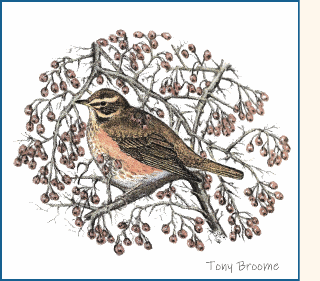
A Massive Redwing Migration
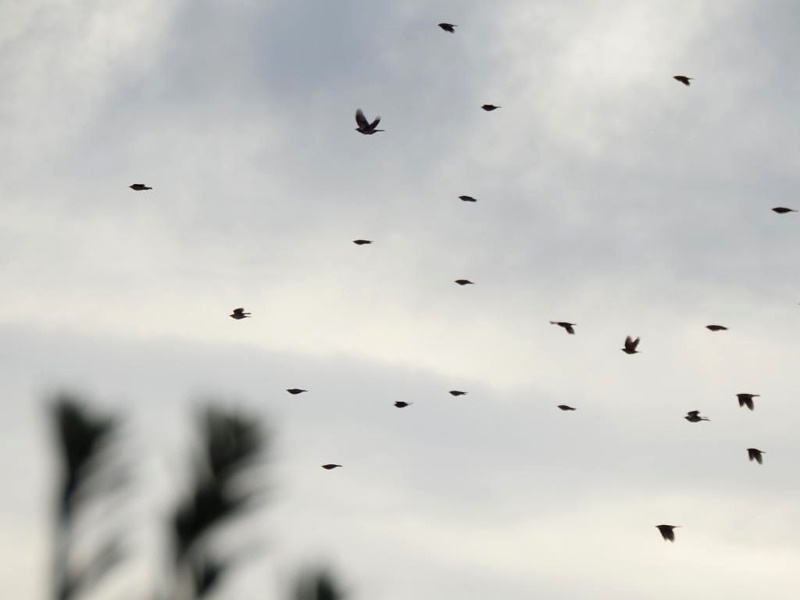
I woke up on the morning of Wednesday 19th October
at first light and looked out of the window. Overcast and a bit breezy
and I thought it was going to be a bit of a nothing day. Then I saw a
small flock of Redwings fly over - my first of the autumn so I was
pleased. Another flock came over, unusual over my house in October when
I normally only see them in winter when they come into the adjacent
Stapledon Wood. Then I started getting texts - "some superb vis mig at
Thurstaston this AM. Big movement of Redwings" "at West Kirby
Marine Lake and there are big Thrush flocks piling in! Spectacular!!"
"1000s of fieldfares/redwings flying over Thurstaston camp site now".
As soon as I drove down Station Road at Thurstaston
I could see the loose straggly flocks typical of Thrush migration. The
flocks were big and in the 30 minutes I was counting I had at least
2,000 Redwings and 500 Fieldfares, just fantastic to see. Before I
arrived Steve Hinde had done a count of 4,080 Redwing and
1,125 Fieldfare between 0800hrs and 0915hrs, so they were still coming
through at the same rate. Redwings largely migrate at night but will
keep on going the following day if conditions are right. But sooner or
later they have to stop for food and this is what they were doing in
the afternoon with large numbers in the fields and in the hedges. One
observer said "I have just walked through Dawpool NR, every berry tree
was alive with them. They where like locusts. Then a Sparrowhawk
spooked them all, what a spectacular sight."
As they dropped down to feed the overhead passage eased off. Taking that into account and using various counts people made during the day I've estimated that there was a minimum of 15,000 Redwings over Thurstaston that day, but 20,000+ seems quite likely. To put that in perspective a count of two or three thousand would normally be considered exceptional. You can see from the map that Thurstaston's location means it is always a good site to see visible migration as birds arrive there both from along the coast and those flying along the valley between Thurstaston and Caldy/Grange Hills, and, as they continue into the estuary, the birds tend to disperse over Heswall and Parkgate marshes.
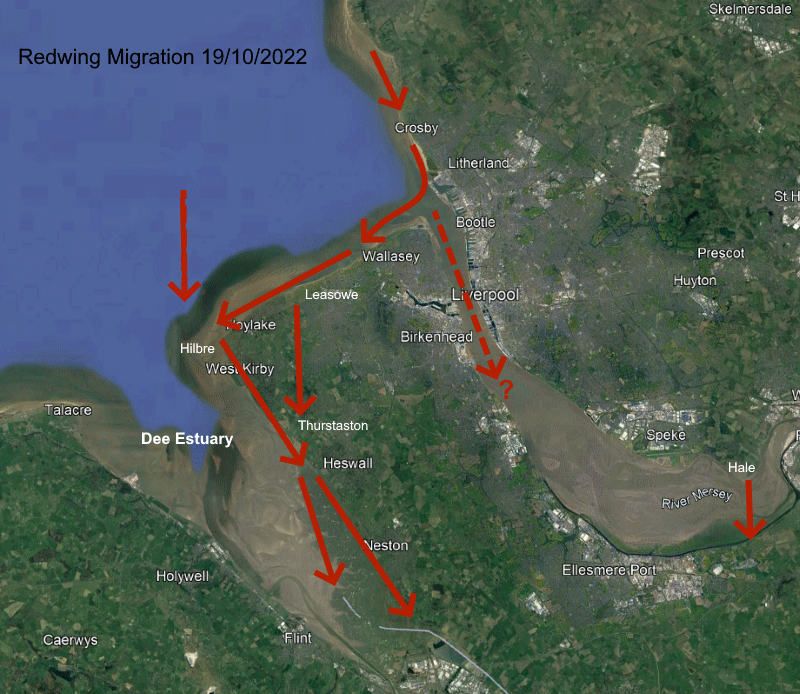
Redwings were everywhere on the 19th
but the red arrows show the main routes. Observers at Hilbre bird
Observatory had birds flying in from the north and thus bypassing
Crosby. The ones at Hale were also in addition to the massive count at
Crosby - incredible numbers! It seems likely that some flocks carried
on flying south-east and into the River Mersey although there were no
reports from along that stretch.
In the evening I do what I always do and that is
look at BirdGuides to see what has been seen in our local area - and I
couldn't believe what it was telling me. 122,600 Redwings over Crosby
Marine Park between 0730hrs and 1430hrs, surely that was a mistake??
But it wasn't! I'm pretty certain that is the highest single site count
of Redwings ever made in this country. Just two miles due south of
Crosby is New Brighton, and due south is precisely the direction that
enormous number of Redwings were going. We know from previous
experience that most migrating thrushes (and other passerines) come
down that coast past Formby and Crosby then turn south-west along the
north-wirral coast, as indicated on the map. On the 19th it is likely
that many did indeed do that but many may also have continued into the
River Mersey whilst others dispersed across Wirral. It's easy to be
wise after the event but how great it would have been to have had
migrant watchers all day placed at New Brighton, Leasowe Lighthouse,
Red Rocks and Thurstaston to give us accurate counts of this
exceptional migration and monitor the flight paths, but sadly that
wasn't the case.
There was one other site in Cheshire where an
accurate count was made, this was at Hale Head on the north shore of
the Mersey Estuary and a well known migrant hot spot. Birds were
counted between 0915hrs to 1125hrs with a total count of 11,427
Redwings. It was known that birds had been flying over since dawn and
were still coming over when the counter had to leave so a conservative
estimate of the day's total would be to at least double that number.
But note those 20,000+ will have been in addition to those counted at
Crosby and Thurstaston, as you can see from the map.
The majority of Redwings we see in this country
breed in the vast forests of northern Russia. In the autumn they head
south-east and on Tuesday 18th October large numbers must have been
using southern Norway as a staging post, no doubt feeding up before
heading south. That evening conditions were perfect for a southerly
migration,
clear with a light northerly winds. As they took to the air they
started showing on the weather radars as shown in the maps below - by
8pm the Redwings, for that is what most of them were, covered an
astonishing 50,000 square miles of southern Norway and they were
starting to head out into the North Sea.
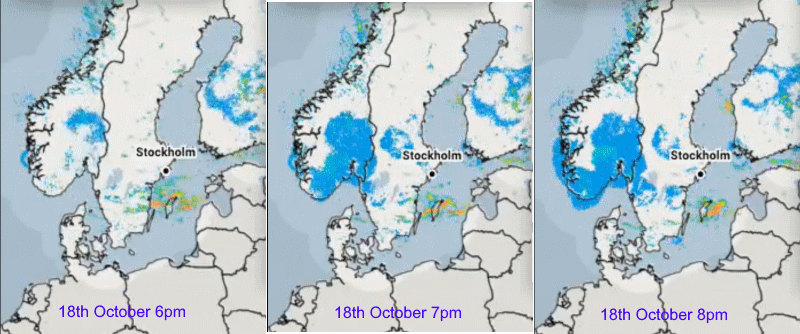
Weather Radar in southern Norway and
Sweden. The blue areas are migrating birds.@vogeltrekinfo.
All the following day (19th) the Redwings were
recorded flying south right down the eastern North Sea coast from
northern Netherlands to France with several sites reporting record
numbers including 214,838 at Den Haag and 350,080 at Westenschouwen.
But as they left Norway many also ended up in the UK blown there by a
fresh
easterly wind. Over 4,000 were identified by their nocturnal flight
calls that night coming in off the North Sea at Jarrow, County Durham,
and it's likely that it was along that coastline most of them made
their landfall. By
dawn the large majority where all heading south in a relatively
small area, inside the square shown on the map below. Records
were
being broken all over that area including 43,000 at Ryther in North
Yorkshire, 31,670 at Lytham on the Ribble Estuary whilst 18 miles
inland of the Ribble 66,000 flew over Winter Hill and 18 miles south of
the Ribble we had that massive count at Crosby.
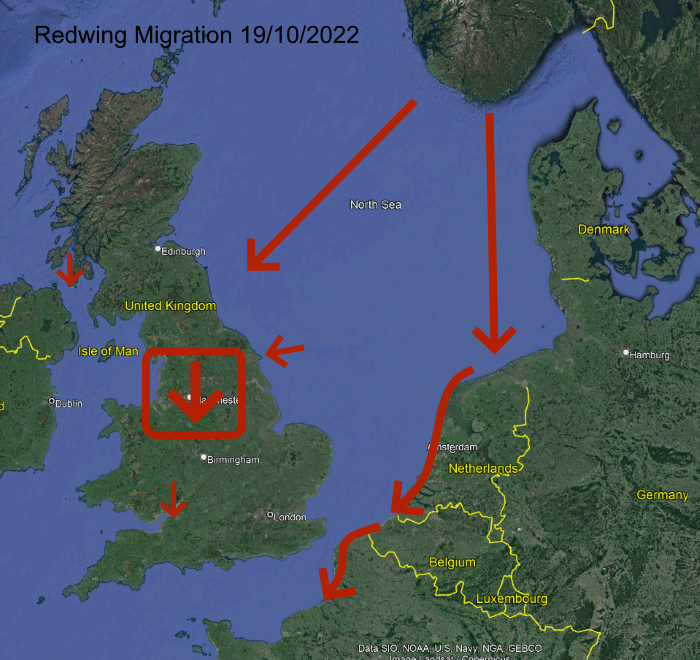
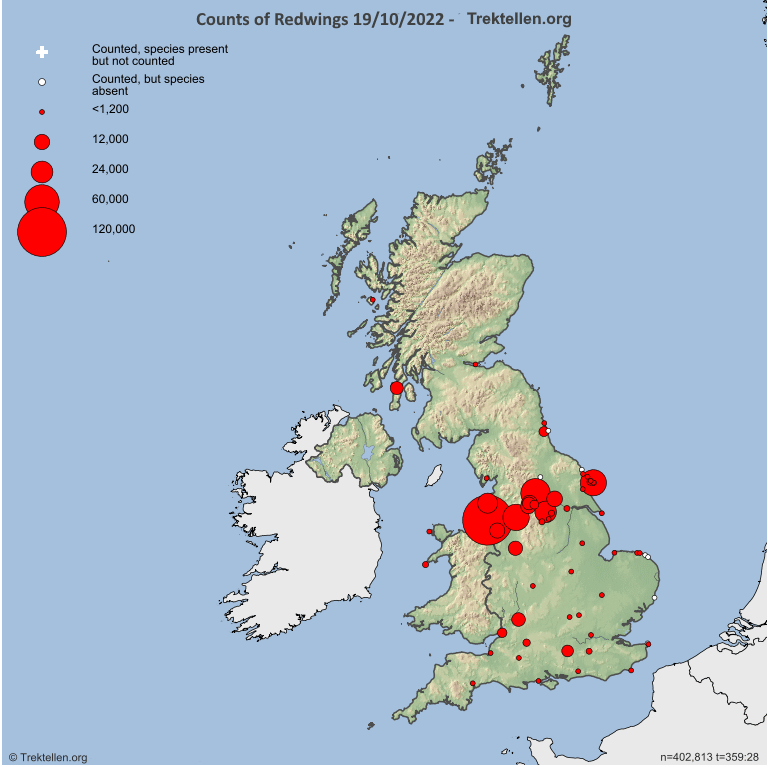
The Trektellen map shows those counts
reported to that website. The large red circle to the west is Crosby,
that on the east coast is Flamborough, then all the large counts in
between. The small red circle on the English north-east coast (at
Jarrow) is a
count of nocturnal calls obtained on the night of Oct 18th/19th when
the birds were coming in off the North Sea.
Redwings were recorded elsewhere in the UK that day, but appear to have been fairly localised. The Mull of Kintyre, on the west coast of Scotland, saw 8,380 fly over in the morning and was the only significant count north of our 'square' that day. To the east Flamborough Head had a very high count of 33,743, also in the morning. They were coming in off the sea and these were the only big flocks reported that day to be flying west, and not south. They must have been coming in off the North Sea in a very narrow front as no other east coast site reported any significant movement of Redwings that day. To the south-west Painswick Beacon in Gloucestershire had over 9,000 Redwings mostly coming over in the morning, so these must have arrived earlier into the country than the main wave further north.
The next day (20th) nearly all records came from the south of England including 9,000 at Severnside (Gloucs) where most birds were recorded flying south-west. Total numbers in the UK were small compared with the previous day so the majority of the massive passage of birds appear to have continued on south on the night of the 19th/20th flying over the English Channel on their way to the wintering grounds in France and Spain.
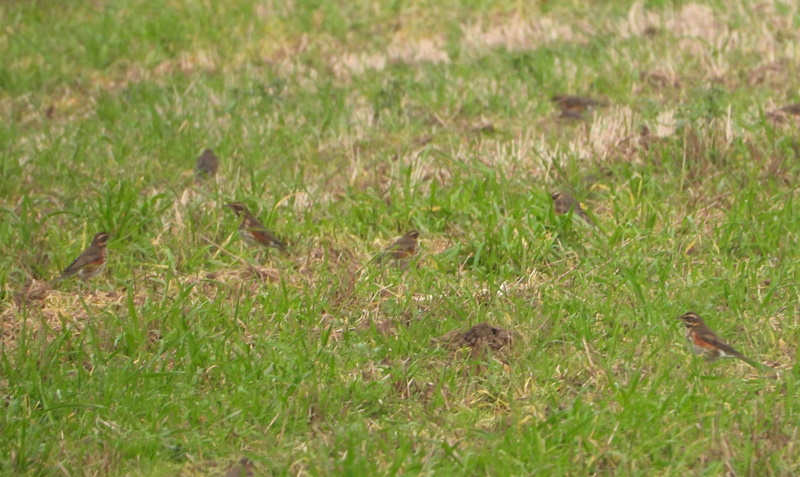
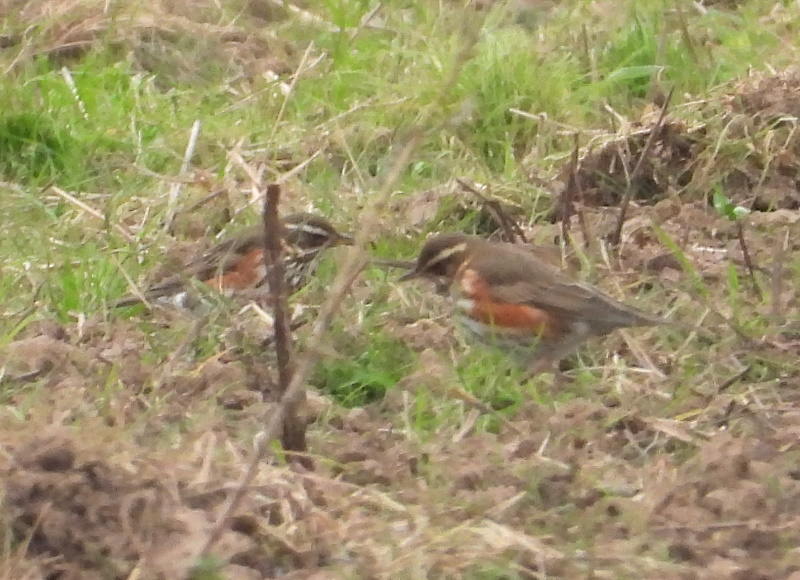
Historical Records
When all the data is in it is likely that October 19th 2022 will be seen as the largest single day passage of Redwings ever seen in this country, and that the 122,600 Redwings counted flying south along the coast at Crosby will have been the largest ever single site count ever made in the UK. For those of us lucky to see it it was an awesome experience. But how does October 2022 compare to previous years?
On the Dee Estuary the most regular and largest
counts have all come from Red Rocks, and there have been two
five-figure counts - 11,150 on October 22nd 1979 and 10,500 on October
16th 1993. At Hale Head, on the north bank of the Mersey Estuary,
visible migration counts have been made regularly since 2007 and,
again, there have been two five-figure counts before 2022, with 11,307
on October 29th 2009 and 10,848 on October 31st 2014. The graphs show
an interesting difference in weekly distribution between what happens
on the
coast, at Red Rocks, and at Hale Head 14 miles inland. It would seem at
the coastal site of Red Rocks the migration is much more concentrated
over the second half of October than at Hale where birds are flying
over throughout October and November.
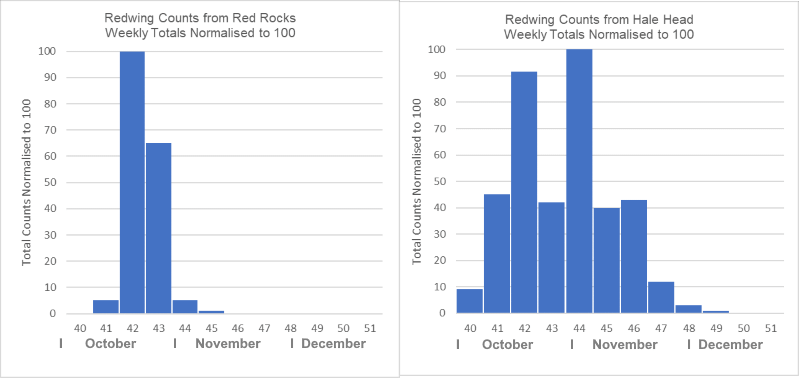
Previous to 2022 there seems to have been very few
counts of
Redwings nationally over 20,000, with 32,000 over Flamborough Head on
October 13th 2020 seen as an exceptional count. But there was one year,
2004, which was extraordinary and was the subject of a British Birds
article (Ref 6). I quote:
The Redwings appeared to be using three separate and
quite narrow
flyways, over Pilling (south shore of Morecambe Bay), over Marshside
RSPB (south shore of the Ribble Estuary) and over Whitley Reed in north
Cheshire - all flying the 'wrong'
way, i.e. north-east or north. At Whitley Reed an initial estimate of
100,000 over in just three hours was revised downwards to 50,000 -
60,000, still a remarkable number, and the total number of thrushes
over north-west England was estimated at nearly 145,000, the vast
majority being Redwings. After analysis of the weather patterns over
that weekend the authors concluded that the birds had flown south from
Scandinavia down the North Sea coasts in ideal conditions but then hit
a storm over northern France which caused them to reverse direction and
they ended up flying over the north-west of England as described.
Presumably they then completed a circle as they later headed south
again.
Acknowledgments and References
1. Thanks to all those 'vis mig' counters, many of who spent long hours
out in the field on October 19th. Particularly Barrie Armitt at Crosby
without who we wouldn't have realised just how massive this movement
was. He was there from 0730hrs to 1430hrs. Also Rob Cockbain at Hale,
and Steve Hinde, Matt Thomas and Ian Goldstraw at Thurstaston - and
many others throughout the country. 2. Thanks to @vogeltrekinfo who posted the weather radar map (Norway/Sweden) on Twitter.
3. Thanks to Jane Turner for forwarding her Red Rocks data.
4. BirdGuides - https://www.birdguides.com/sightings
5. The Migration and Counts Website - https://www.trektellen.org/
6. Jean Roberts and Steve J. White, An exceptional
movement of Redwings across northwest England in October 2004, British
Birds 99, February 2006.
Richard Smith
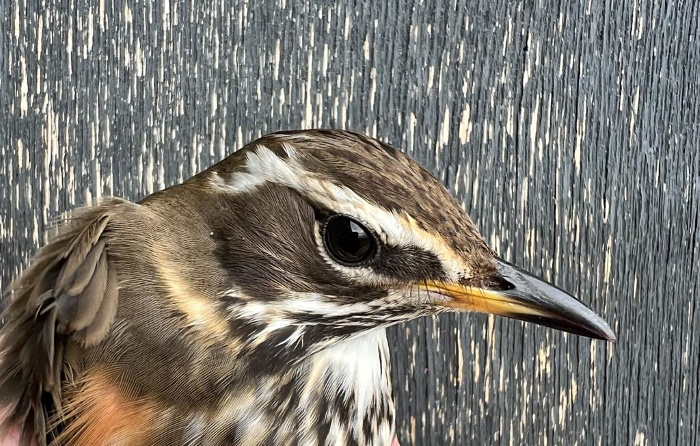
Colour Ring Report
Knots
The Knots returned in good numbers during November
with a notable influx on the 16th, and judging by the ringed birds
we've seen many of these had spent the autumn on the Wash where huge
numbers were counted at RSPB Snettisham. Over the past six weeks (up to
the end of November) we've
had 92 records of colour-ringed Knots and included on that list where
some which were ringed locally at Hoylake on November 25th by
Merseyside Ringing Group and five of these have already been spotted.
As well as Knots ringed locally at Hoylake, Altcar and Ainsdale we've seen birds ringed on the Orkneys (a first for us), the Netherlands, Iceland and Norway. Photos and details of four of them below.
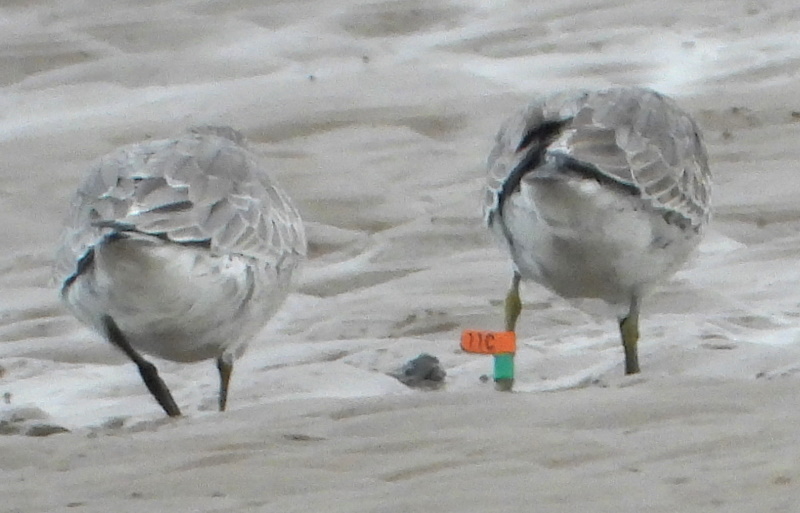
Orange Flag (11C) over green ring - ringed at Hoylake on November 25th 2022 and has already been recorded at Meols (27th) and Thurstaston (28th). Here photographed at Meols on Nov 27th © Richard Smith.
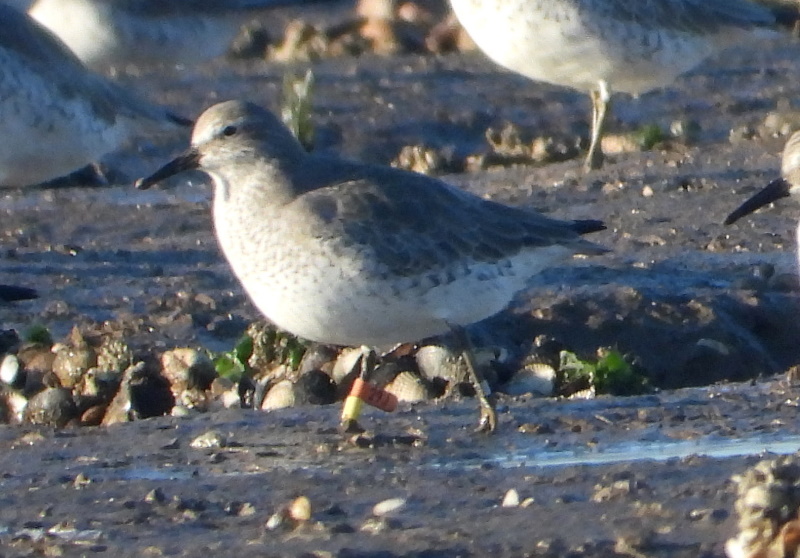
Orange Flag (29J) over yellow ring. This was at
Thurstaston on November 16th. We knew that it's yellow ring meant that
it had been ringed in Scotland, but we got a nice surprise when we
found out that it had been ringed on the Island of Sanday on the Orkney
Islands - our first from there. It was ringed on May 14th 2022 and was
then about 10 months old. Presumably it had traveled north with the
adults before deciding it didn't really want to cross the Atlantic at
that young age as it was next seen in June on the Waddensea
(Netherlands) where it spent the early summer. Photographed at
Thurstaston on Nov 16th ©
Richard Smith.
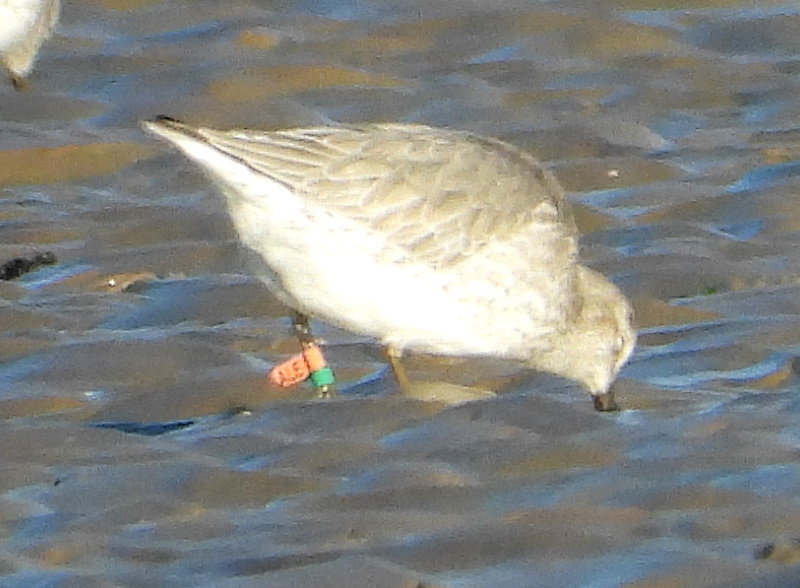
The Irish Sea population of Knots - those that are
here throughout the year apart from the two or three months when they
are breeding - mostly migrate to Canada in order to breed by first
stopping off in Iceland to feed up in May. In fact nearly all stop in
south-west Iceland and Orange Flag (ALE) is no exception having been
recorded at Hitarnes, just south of the Snaefellsnes Peninsula, both in
May 2019 and May 2022. It was ringed at Altcar in March 2018 and it's
movements are typical of this local population. On returning to this
country after breeding it spends late summer and autumn around the
Ainsdale, Formby and Crosby area before turning up in the Dee Estuary
usually in November (including Nov 29th 2022) where it stays until
January. In both 2019 and 2020 it was recorded in Dublin Bay in late
winter before returning to Ainsdale, Formby and Crosby in March and
April. Knots aren't always predictable, however, and in September 2019
it turned up at Gibraltar Point on the north-east corner of the Wash
having been at Crosby in July and then turning up at Southport in
October.
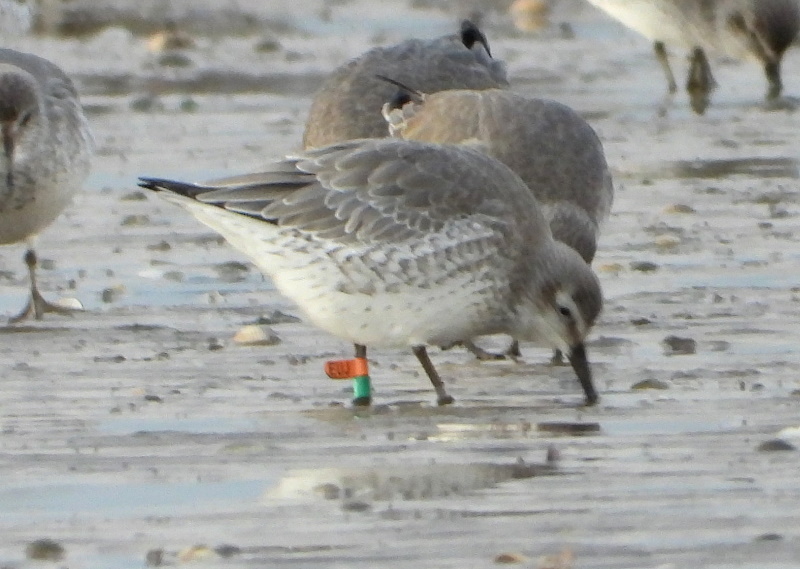
'ALE' has been recorded a total of 28 times, but when I saw Orange Flag (EUJ) at Meols on Nov 27th it was only the eighth time it's been seen. This is a North Sea bird, undergoing pre and post breeding moult either on the Dutch Waddensea or the Wash, and only visiting us here on the Dee Estuary in winter. It also follows a very different route to it's breeding grounds in Canada than our local birds, stopping over in May on the northern tip of Norway at Porsanger where it was recorded in both 2019 and 2021.
Curlews
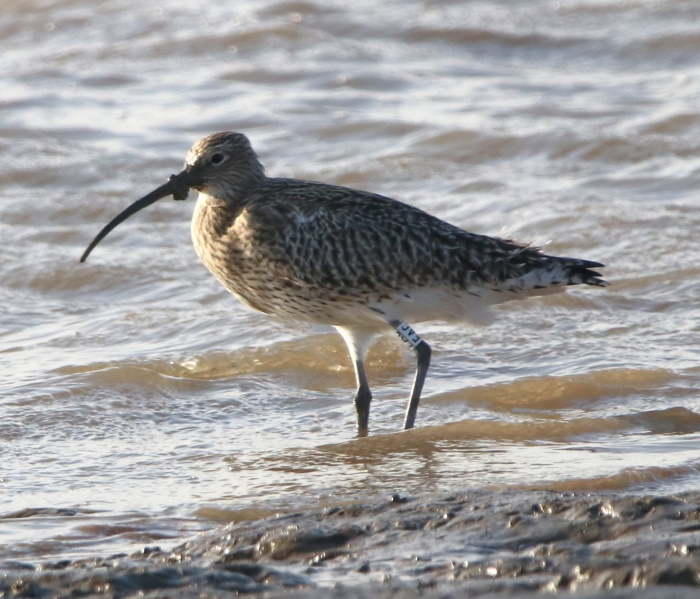
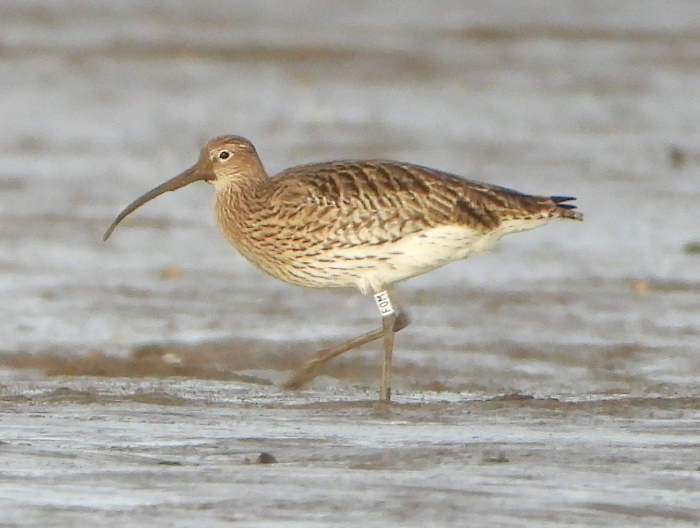
These two Curlews were both ringed in Finland and
return here to the Dee Estuary to the same area of mudbank every year,
being present from July to April.
FAC was ringed as a juvenile at Haapavesi in Finland on July 6th 2017.
First recorded at Heswall in June 2018 when it would have been
over-summering as a non-breeding young bird.
FOM was ringed as a nestling at Siikalatva in Finland on June 28th 2018.
Since ringing it has been recorded back at the ringing site in April
2020 and May 2021. First recorded at Thurstaston in November 2020.
Oystercatcher
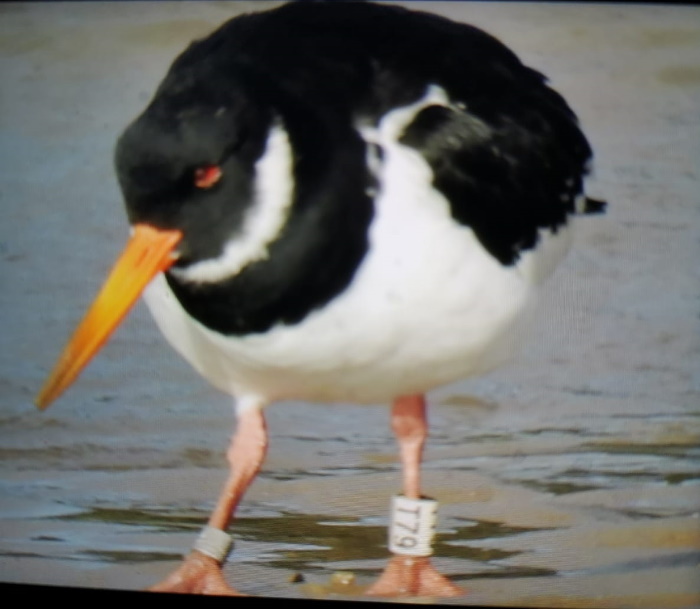
Oystercatcher White (T79). Photographed on Leasowe
Shore on November 8th 2022 © Tony Ormond
In Aberdeen Oystercatchers breed all over the city -
roof tops, gardens etc - and this one was hatched as a brood of three
in the garden of Oldmachar Academy on 17/06/2019.
Other sightings of T79 have been at New Brighton in November 2019 and
Seaforth in September and November 2021.
Cormorant
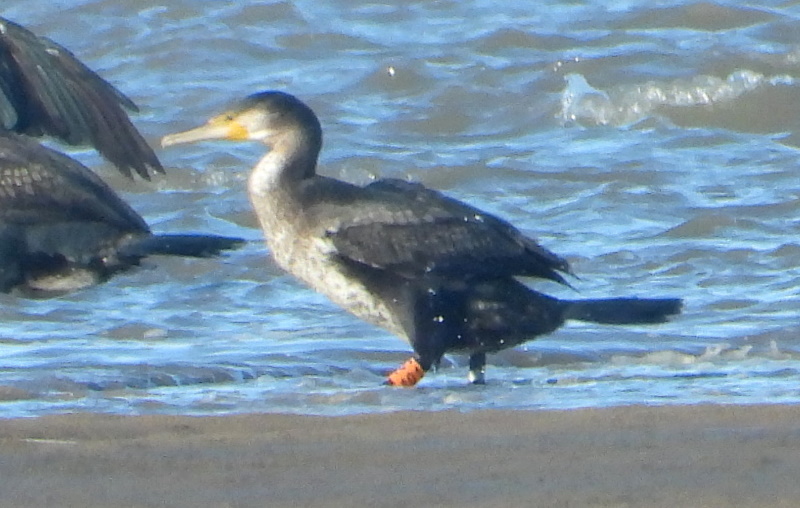
Cormorant Orange (101) at Hoylake on October 28th © Richard Smith. We'd been seeing an orange ringed Cormorant for several weeks, always on the edge of East Hoyle Bank on the rising tide but it had always been too far to read the ring. On Oct 28th it was just a bit closer in perfect conditions when I photographed it under full zoom and pleased to see I'd managed to get the number!
Ringed as a nestling at Hale Duck Decoy on
18/05/2022, recorded at Hilbre on 28/09/2022 and at Hoylake on
28/10/2022.
Out of interest another one ringed as a nestling at Hale Duck Decoy
this May (Orange - 93) has just been reported at the Del Burgo Estuary
in north-west Spain.
Colour Rings were recorded by Richard Smith, Stephen
Hinde, Richard Speechley, Tim Kinch, Alan Hitchmough, Tony
Ormond, Richard Jones and Colin Schofield.
Richard Smith
November Bird News
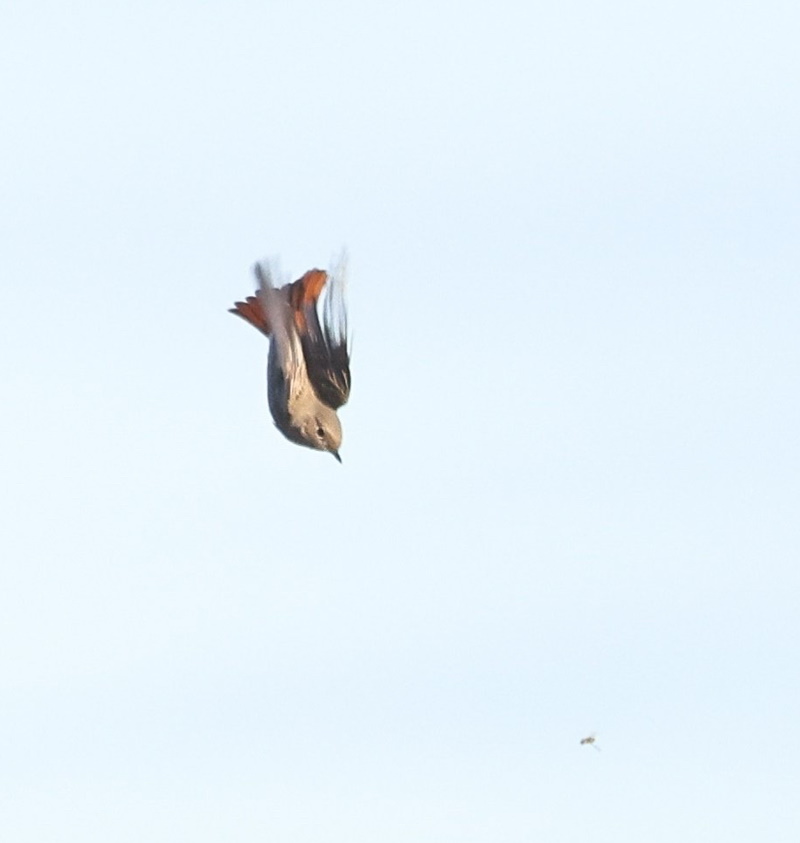
Mild weather with southerly winds for much of the month meant for some late departing summer visitors including a Sandwich Tern on the 5th and an Arctic Tern on the 9th. Although it is possible to see one or two Gannets in winter they are very unusual and 30 off Leasowe on the 20th was unexpected. There was a late Curlew Sandpiper at Burton Mere Wetlands on the 3rd.
Out to sea there have been good numbers of Common Scoters with 8,000 the highest count. But it was particularly good to see large numbers of Great Crested Grebes back off North Wirral with 589 on the 16th the highest count since 961 in October 2015. With these large flocks were a few scarcer species including a Long-tailed Duck, a Great Northern Diver, plus several Velvet Scoters and Red-throated Divers.
It's been a good autumn for Firecrests including five ringed in one garden on Bidston Hill! There were also two in a Long-tailed Tit flock along Meols Drive on the 15th. It's also been a good autumn for Black Redstarts and one was seen well at Hoylake Lifeboat Station several times. A Siberian Chiffchaff was close to Leasowe Lighthouse for several days and a Glossy Ibis was at Burton Mere Wetlands, the latter was a bit elusive usually only flying in to roost overnight.
There was a notable influx of Knots from the east
mid-month, I was lucky enough to see a large flock at Thurstaston
putting on a wonderful display, and I was the only one to see them!
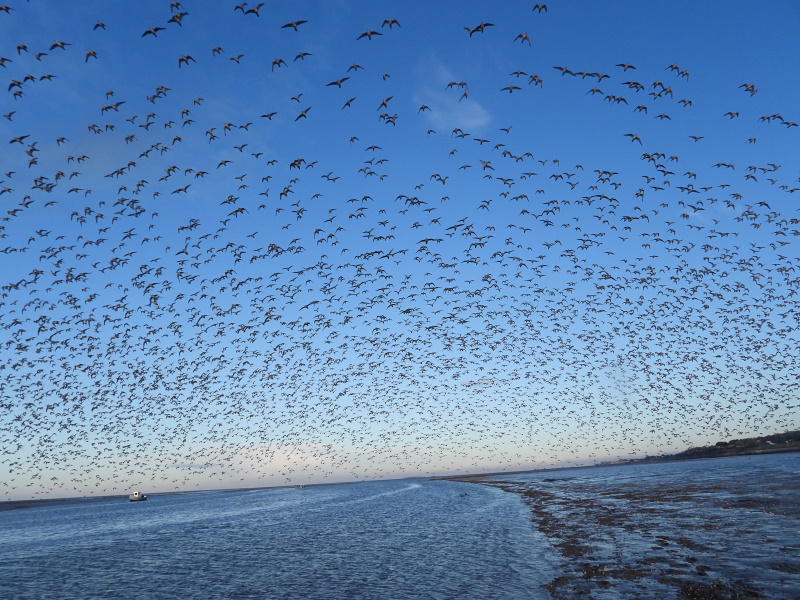
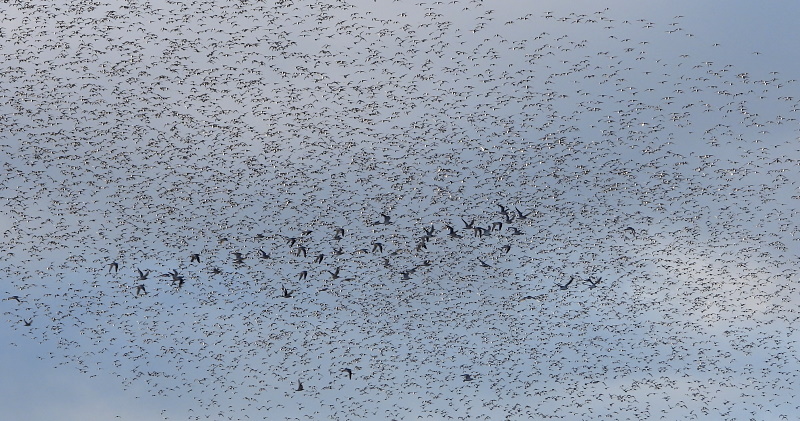
What to expect in December
Both Hen Harriers and Short-eared Owls were very thin on the ground in November, so lets hope for a cold spell which should bring a few more to the marshes. Marsh Harriers are plentiful and it would be good to do a count of them coming to the roost off Parkgate - not easy as they are coming and going from mid-afternoon and some almost certainly fly in after dark, I wouldn't be surprised if there are at least 20. Also on the marsh is at least one Bittern and that's usually seen flying into the roost at Parkgate before dark.
Both Brent and Pink-footed Geese are doing well on
the estuary. It's likely that we'll get over 500 Brents around Hilbre
and good views can also be had of small flocks at Thurstaston and along
the coast at Meols and Leasowe. Pink-footed Geese will be everywhere
and can often be seen flying to and from inland fields.
There will be Snow Buntings around, Gronant and
Point of Ayr are probably the best sites and there are normally at
least two or three along North Wirral, and on Hilbre.
Forthcoming Events
December Highest Spring Tides (Liverpool)
Also see Tides page.
24th December, 11.24hrs (GMT), 9.6m.
25th December, 12.13hrs (GMT), 9.7m.
Forthcoming Events
See events at https://events.rspb.org.uk/deeestuary